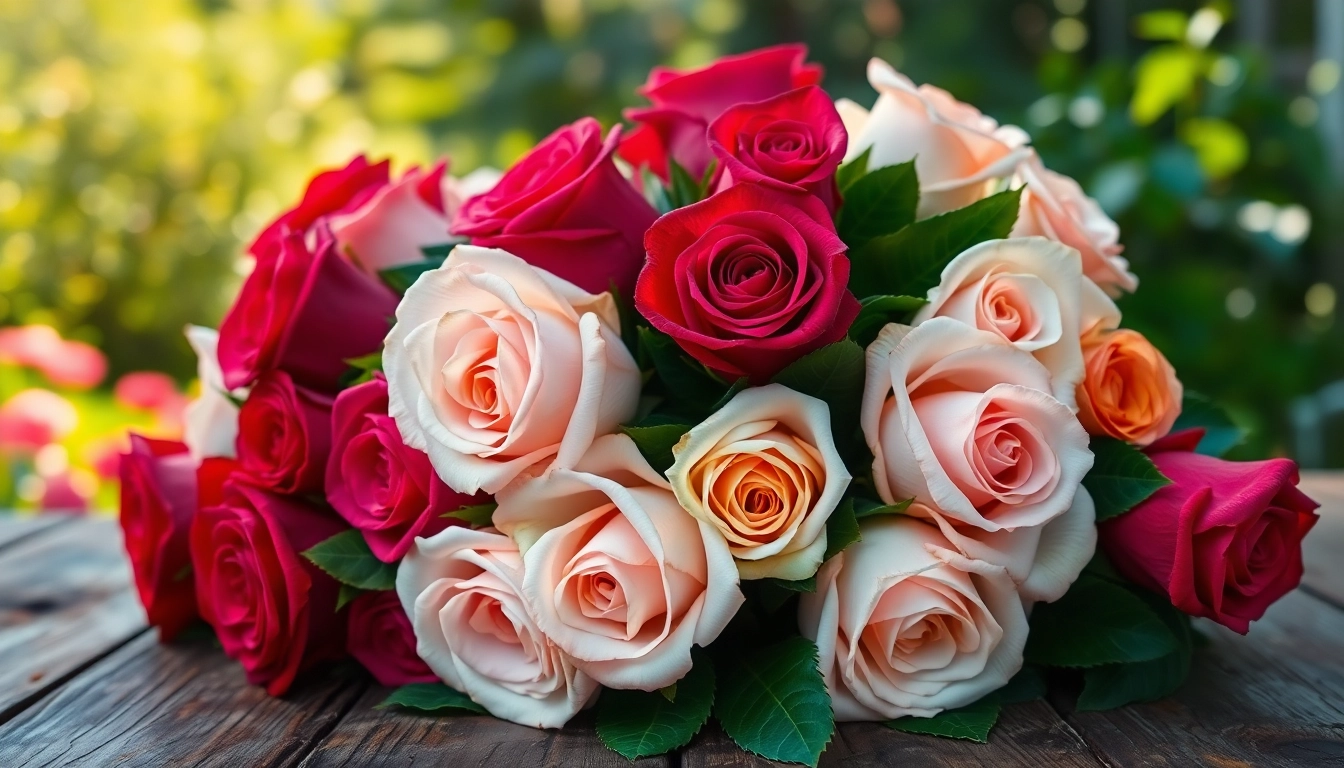Understanding the Symbolism of Roses
Roses have captivated humanity for centuries with their stunning beauty and rich fragrance. Beyond their aesthetic appeal, roses hold deep symbolism and meanings across cultures and societies. Their significance can be seen in various facets of life—from language and art to traditions and rituals. For enthusiasts and gardeners alike, understanding the multifaceted nature of roses is essential. In this comprehensive exploration of roses, we will dive deep into their symbolism, varieties, care tips, and more. If you’re intrigued by these flowers, you’re in the right place, and don’t forget to check out rose varieties available for your garden.
The Language of Roses: Colors and Meanings
The colors of roses each carry distinct meanings. For example, red roses symbolize love and passion, while white roses represent purity and innocence. Pink roses convey admiration and gratitude, and yellow roses are associated with friendship and joy. Understanding the meanings behind these colors can enhance the emotional depth of your floral gifts; for instance, presenting a friend with a bouquet of yellow roses can be a beautiful gesture of appreciation.
Moreover, the symbolism of roses extends beyond their colors. Black roses, often associated with mourning, signify the end of a relationship or the loss of a loved one. Conversely, blue roses, which are rare in nature and often seen as unattainable, symbolize mystery and the elusive nature of desire. This complex language of roses allows individuals to express emotions that may be difficult to articulate verbally.
Roses in Literature and Art
Roses have been an enduring subject in literature and art, symbolizing diverse emotions and themes. From William Shakespeare to modern poets, roses appear as a powerful motif signifying love, beauty, and the fleeting nature of life. Shakespeare utilized the rose extensively in his work, famously stating in “Romeo and Juliet,” that a rose by any other name would smell as sweet. This powerful imagery connects notions of identity and love through the lens of beauty.
Artists throughout the centuries have also been captivated by roses. The Impressionist movement saw numerous painters, such as Claude Monet, highlighting roses in their works to explore themes of light and color. More contemporary artists, like Georgia O’Keeffe, have emphasized the sensuality of roses in their artwork, showcasing the flower’s natural curves and textures. Through these artistic expressions, we gain insights into the cultural significance and pervasive allure of roses.
Cultural Significance of Roses Around the World
Culturally, roses hold a prominent place in numerous traditions and practices worldwide. In Western cultures, roses are often a staple in romantic gestures, particularly during Valentine’s Day or at weddings. The symbolism attached to roses often underscores significant life events, including births, anniversaries, and memorials, further connecting roses to the tapestry of human experience.
In Eastern cultures, roses also find their significance. In Persian culture, for instance, roses are often used in poetry as symbols of beauty and love. Persian gardens, which prominently feature roses, represent paradise and beauty, echoing the sentiments expressed in classic Persian literature. Similarly, in Chinese culture, different colored roses hold varying meanings, such as red for romantic love and pink for admiration.
Types of Roses: A Comprehensive Guide
Popular Varieties for Your Garden
When it comes to selecting roses for your garden, the options are abundant. Some popular varieties include:
- Hybrid Tea Roses: Known for their large blooms and classic shape, these roses are often featured in bouquets.
- Floribunda Roses: These are bushier and produce clusters of flowers, perfect for vibrant garden displays.
- Climbing Roses: Ideal for trellises and arbors, climbing roses can add height and elegance to your garden.
- Miniature Roses: Compact and charming, miniature roses are often grown in pots and make delightful indoor plants.
Selecting the right variety for your garden can heavily depend on your climate, available space, and personal preference. Each type of rose brings its own unique beauty and charm, ensuring that there is a variety suited for every gardener’s needs.
Seasonal Differences: Which Roses to Plant When
Understanding seasonal blooming patterns is essential for maximizing the beauty and health of your rose garden. Generally, roses are best planted in spring or fall, depending on your climate. In warmer regions, fall planting may result in stronger root systems due to cooler temperatures, while those in colder climates might prefer planting in spring after the last frost.
Some rose varieties also have specific seasonal characteristics. For instance, early-blooming varieties like ‘April Moon’ can provide a vibrant display as soon as spring arrives, while late-blooming varieties like ‘New Dawn’ can extend the blooming season into autumn. By diversifying your selection across the planting calendar, you can ensure an extended floral display that fills your garden with color for most of the year.
Hybrid vs. Traditional: Making the Right Choice
The choice between hybrid and traditional roses depends on several factors, including gardening style, landscape goals, and maintenance preferences. Hybrid roses, which have been selectively bred for specific traits, tend to exhibit enhanced resistance to diseases and pests, making them a popular choice for novice gardeners. Their stunning blooms, diverse colors, and fragrance also make hybrids immensely appealing.
Traditional roses, on the other hand, hold a unique charm rooted in history. These varieties may have lower disease resistance but are often prized for their fragrance and historical significance. Gardeners may find joy in nurturing these older varieties, feeling a connection to the gardening practices of generations past.
Growing and Caring for Roses
Essential Tips for Planting Roses Successfully
Successfully growing roses involves several essential tips that every gardener should consider. First, choose well-drained soil with an optimal pH between 6.0 and 6.8, as roses thrive in rich, loamy conditions. Prior to planting, amend your soil with organic matter to promote good drainage and fertility.
When planting, consider the location. Roses favor full sun, ideally receiving six to eight hours of sunlight a day. Adequate sunlight promotes healthier plants and enhances blooming vigor. Additionally, space your roses appropriately to ensure good air circulation, which helps to prevent fungal diseases.
Pruning and Maintenance Best Practices
Regular pruning is a crucial component of rose maintenance, supporting healthy growth and encouraging abundant blooming. Pruning should generally be done in late winter or early spring before new growth emerges. Remove dead, diseased, or crossing stems to open up the center of the plant and allows for good air circulation. This practice also encourages new growth and flowering throughout the season.
In addition to pruning, regular maintenance includes watering practices, pest management, and fertilization. Roses require consistent watering, especially during dry spells, but it’s essential to avoid overwatering. Mulching can help retain moisture and suppress weeds. When it comes to fertilization, a balanced fertilizer during the growing season can help support blooming and overall plant health. Always monitor for pests such as aphids or spider mites, and treat infestations promptly to prevent damage.
Common Pests and Diseases: Prevention and Remedies
Even the most vigilant gardeners may encounter pests or diseases affecting their roses. Common threats include aphids, black spot, and powdery mildew. Preventive measures can significantly reduce the likelihood of these issues. Regular inspections, maintaining good air circulation, and keeping foliage dry can help prevent many fungal diseases.
For pest control, introducing beneficial insects, such as ladybugs, can help manage aphid populations naturally. If chemical treatment is needed, ensure to select products specifically designed for roses and follow application guidelines carefully to minimize harm to beneficial insects and the environment.
The Aesthetic Appeal of Roses in Home Decor
Using Roses in Arrangements and Bouquets
The aesthetic appeal of roses transcends their presence in gardens, as they play a significant role in floral arrangements and home decor. Roses can be styled in various ways, whether in simple bouquets, elaborate centerpieces, or decorative installations. Their versatility allows for endless creative possibilities.
When creating a bouquet, consider balancing rose varieties, colors, and textures for visual interest. Pairing roses with foliage, such as eucalyptus or ferns, can enhance the natural beauty of the arrangement. Understanding color theory can also elevate your designs; for example, combining complementary colors creates stunning arrangements that draw the eye.
DIY Rose Crafts for Every Occasion
Roses provide a wonderful medium for DIY crafts beyond traditional arrangements. Rose petals can be used to create potpourris, adding a romantic fragrance to your home. Dried rose petals can also be incorporated into homemade soaps or candles, adding both visual appeal and delightful scents.
Another creative use of roses is making rose water, a gentle facial toner that can hydrate and refresh the skin. To create rose water, simply simmer fresh rose petals in distilled water, then cool and strain the mixture. The result is a versatile skincare product that captures the essence of roses in every drop.
Incorporating Fresh Roses into Your Living Space
Fresh roses can breathe life into any living space with their vibrant colors and enchanting aromas. Positioning vases of fresh roses in common areas, such as dining tables or entry halls, provides an inviting atmosphere. Using varied heights and sizes of vases can create visual interest and dimension.
Beyond vases, consider incorporating roses into larger decorative elements, like table runners adorned with rose petals or framed botanical art featuring pressed roses, to celebrate the beauty of this beloved flower.
The Health Benefits of Roses and Rose Products
Nutritional Value of Rose Hips
Roses provide more than just beauty; their hips, the fruit of the rose plant, boast several health benefits. Rich in vitamins A, C, and E, rose hips provide an impressive nutritional profile. Their high vitamin C content makes them an excellent immune booster and contributes to skin health.
Additionally, rose hips are known for their anti-inflammatory properties, aiding in joint health and overall wellness. Incorporating rose hips into your diet can be as simple as brewing them into teas or using them in jams and marmalades for a nutritious twist on traditional recipes.
Rose Water: Uses and Benefits
Rose water, a fragrant byproduct of rose petals, has long been celebrated for its soothing properties. Commonly used in skincare, rose water is known for its ability to moisturize, tone, and rejuvenate the skin. It also has gentle anti-inflammatory properties, making it suitable for sensitive skin types.
Beyond skincare, rose water has culinary uses, particularly in Middle Eastern and Indian cooking, adding a floral note to dishes and beverages. Using rose water to enhance recipes not only introduces a unique flavor but also highlights the versatility of roses.
DIY Recipes with Roses: From Skincare to Infusions
Creating DIY products with roses can be a fun and fulfilling experience. From skincare to culinary infusions, the possibilities are endless. For a simple rose facial mist, combine distilled water with rose water and a few drops of essential oil for a refreshing spritz. Alternatively, for a flavorful infusion, consider making a rose-infused simple syrup by simmering rose petals with sugar and water; this syrup can enhance cocktails, desserts, and more.
Another delightful recipe involves rose petal jam, using rose petals, sugar, and lemon juice, to create a unique spread that introduces a floral note to toast or pastries. These DIY recipes celebrate the many uses of roses, transforming them from garden favorites to cherished household staples.

